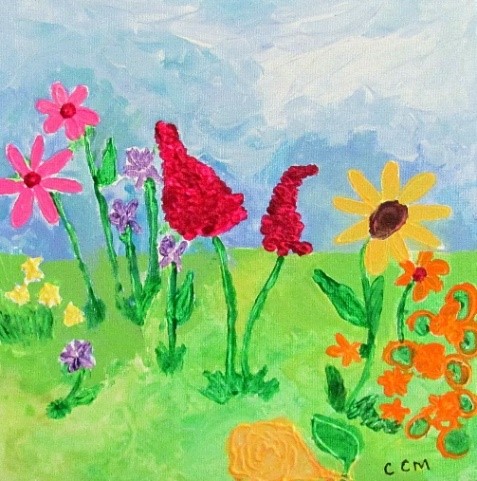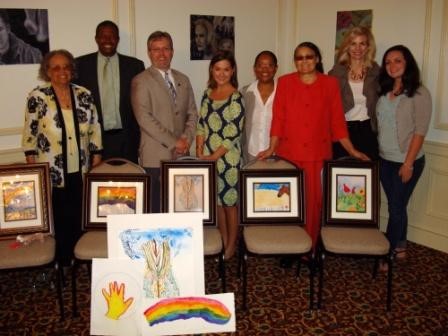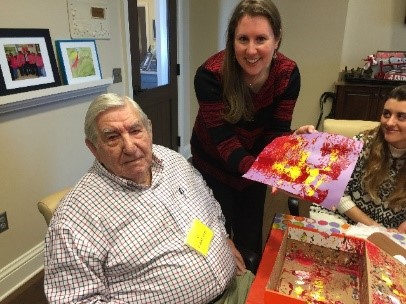By Sarah Margaret Wade, LPC, ATR, NCC | April 27, 2016 | About Art Therapy | Community | #WeAreArtTherapists
I recently attended a celebratory gala and art show at the University of Alabama to honor five years of Art to Life, a program of art therapy and storytelling for adults diagnosed with Alzheimer’s disease and other cognitive disorders. Art to Life is a course sponsored by University of Alabama’s Honors College in collaboration with the Cognitive Dynamics Foundation in Tuscaloosa, Alabama.
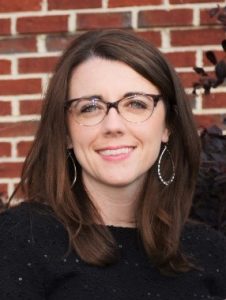
Sarah Margaret Wade, LPC, ATR, NCC
Viewing the art at the gala brought back memories of my involvement as the art therapist with the Art to Life pilot program in Perry County, an impoverished rural community in Alabama. Twice a week, I met with four different families in the countryside with their loved ones, who had been diagnosed with mild to moderate Alzheimer’s. Each family’s home was filled with life-long memorabilia and I came bearing a smile and a cart full of assorted art materials. During art therapy sessions, each piece of art created by participants was like a time capsule, holding stories and treasured memories. The appreciative families were encouraged to reconnect with their loved ones in a new way that brought meaning, creativity, and growth to their family unit. The artwork and process of creating not only honored parts of the participant’s past, but also united them with their abilities in the present.
Art to Life is a program developed with passion by Dr. Daniel C. Potts, a neurologist in Tuscaloosa and founder of Cognitive Dynamics, a non-profit with a mission to improve the quality of life for persons with cognitive disorders, as well as their caregivers. It was inspired by his late father, Lester E. Potts Jr., who was a victim of Alzheimer’s and who found parts of himself again through painting and drawing. Dr. Potts seeks to carry on his father’s legacy by providing innovative care models, such as Art to Life, to other institutions in other regions, and to collaborate with these institutions in research on the intervention of expressive therapies.
- Art to Life original participant artwork
- Dr. Daniel C. Potts (third from left) with original program participants and artwork.
As an art therapist, I’m grateful when I meet physicians who advocate for the expressive therapies. Dr. Daniel C. Potts has designated nationally recognized art therapist Angel Duncan, MA-MFT, ATR as the Executive Arts Director for Cognitive Dynamics; she has been instrumental to the structure of Art to Life, and its emphasis on research and the maintenance of the integrity of the art therapy profession. Additionally, other art therapists from the Alabama Art Therapy Association have reached out to Dr. Potts and contributed to the evolution of the program. With this combined effort, art therapy continues to pave the way towards restoring dignity to senior adults. It was an honor to serve as the art therapist in the pilot program, and our local art therapy chapter has been able to assist this incredible program in a seamless manner over five years.
Karen Gibbons, MA, MFT, ATR continued the program from the fall of 2011 through the spring of 2015. The program naturally evolved and initiated weekly meetings in the basement of a church in Tuscaloosa. Karen provided a variety of art therapy interventions that incorporated breathing and relaxation techniques. She dealt with early challenges and, later promoted Art to Life through an interview for a local TV broadcast and a documentary titled “Bringing Art to Life.” Furthermore, she assisted in the development of an Art to Life program manual. In the spring of 2014 Art to Life moved its sessions to Caring Days, a day program for adults with Alzheimer’s and other memory disorders. It was here that the University of Alabama worked with students to create life story video projects for each participant.
- Karen Gibbons, MA, MFT, ATR, and program participants.
- Carrie May Ezell, PhD, LPAT, NCC, ATR-BC and program participants.
Following the work of Karen Gibbons, art therapist Carrie May Ezell, PhD, LPAT, NCC, ATR-BC, has facilitated art therapy groups for the two most recent semesters. Art to Life is now open to adults (regardless of age) with dementia from any cause, including Traumatic Brain Injuries.
In Carrie’s own words:
The sessions follow a pattern that begins with breathing exercises and gentle movements to help transition the older adults from their previous activity into the art therapy space and to help energize body and mind. Next we go around the table and introduce ourselves and have a quick check in. I explain the day’s activity and answer any questions, then the students initiate art making with their participant. While the participants are working I go around to assist and help model therapeutic skills. As the students come from various majors, it is important to recognize that they may not have an art therapy background and have probably never worked in this environment. Active listening, appropriate questioning, and giving participants space to create and talk takes some getting used to. After the art making we process the pieces as a group, then the participants are taken back to their main room. The students and I then process the experience as a whole and take note of observations, conversations, and elements in the art that tell a story.
My biggest challenge working with Art to Life has been the participants’ belief that they can’t be successful at art making. A lot of our language in the sessions is about exploration and discovery, not artistic talent. As the weeks go on, the negative comments about artistic skill are fewer and further between.
There is a great opportunity for research on the program with other University of Alabama students and myself. I am interested in the data examining participants’ anxiety, stress, and quality of life enjoyment after an Art to Life session. This fall we are planning to implement some research studies to measure the efficacy of the program.
Art to Life has offered me the chance to honor and validate older adults and their full life process. Watching the students interact with their participants and seeing their relationships grow over the semester is just magic! The art becomes a stepping stone for discussion, reminiscence, and play. This program is a reminder that every stage of life is important and everyone has a story to tell.
It is good to see how both Karen and Carrie have left their fingerprints on Art to Life and it is exciting to witness its journey and ongoing evolution. As I left the fifth anniversary gala, I experienced renewed inspiration and was reminded that as stories are told, a connectedness to others can manifest through the making of art, bringing both meaning and a sense of order to life. As the art therapist in the pilot program, I found immense joy in facilitating the healing connectedness for those who participated. The gentle yet potent therapeutic effects of art therapy allow the opportunity for a deeper understanding of self. It is powerful to see others come to life through Art to Life. It was an honor and gift to work alongside the vision of Dr. Daniel C. Potts, and in hindsight, realize the impact I have had in tandem with other art therapists in the community, students from the university, and the participants and families involved.
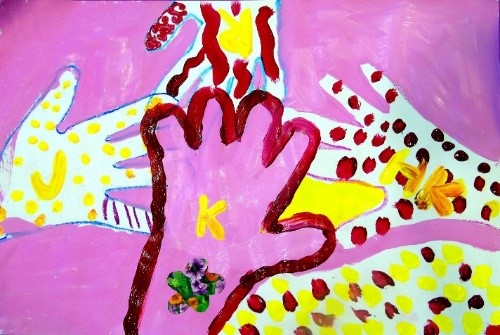
Art to Life participant artwork
All images are displayed with permission from Dr. Daniel C. Potts and the Art to Life program.

